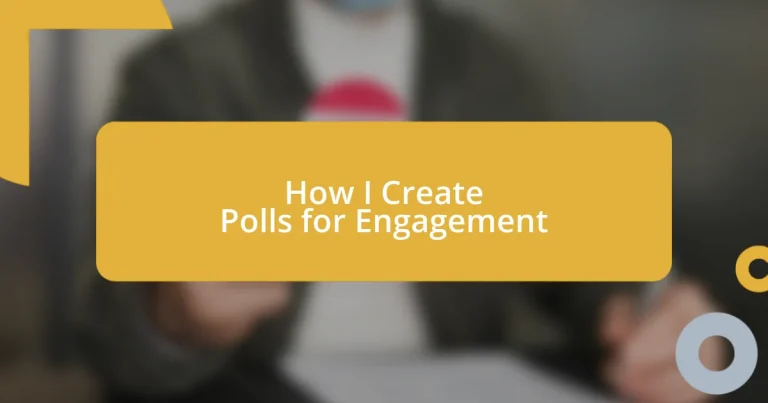Key takeaways:
- Engagement polls are not just data collection tools; they facilitate deeper conversations and foster a sense of community with the audience.
- Choosing the right platform and timing is crucial for maximizing engagement and ensuring that polls resonate with the audience’s interests.
- Analyzing poll results deeply and using insights to shape future content can significantly enhance audience connection and engagement strategies.

Understanding Engagement Polls
Engagement polls serve as a fascinating way to connect with an audience, inviting them into the conversation and making them feel valued. I remember the first time I created a poll, and I was surprised by the lively responses. It felt like I was throwing a virtual party, and everyone was eager to share their thoughts.
These polls aren’t just about gathering data; they’re about sparking a dialogue. When I ask questions, I don’t just think about the answers; I genuinely reflect on how each response can guide my content creation. Have you ever noticed how a simple question can lead to a cascade of ideas and insights? Those moments often lead to deeper connections with my audience than I initially expected.
The beauty of engagement polls lies in their ability to reveal preferences, opinions, and sentiments that otherwise might remain hidden. I once asked my followers about their favorite content format and was amazed by the variety of responses. This insight not only shaped my future content strategy but also made my audience feel heard, creating a stronger sense of community.

Choosing the Right Platform
When I started creating polls, one of the most critical decisions was choosing the right platform. Each platform has its unique features; some excel in user-friendly interfaces, while others offer advanced analytics. For instance, I once opted for a well-known social media platform for a quick poll, and I found the instant engagement exhilarating, but the lack of detailed insights left me wanting more.
I later explored various dedicated polling tools, which provided a comprehensive view of responses. These platforms often offer customization options, allowing me to match the poll’s aesthetics with my branding. There was a time when I used one of these tools for an in-depth survey, and the results were transformative—knowing that I gathered data in a organized format provided me with a sense of clarity and direction for my content.
Ultimately, the right platform can make all the difference in how I connect with my audience and the depth of the insights I receive. I’ve learned that while convenience is essential, the ability to analyze data and engage meaningfully is paramount. How do you prioritize these factors? Based on my experience, weighing your immediate needs against long-term engagement goals will guide you to the best choice.
| Platform | Key Features |
|---|---|
| Social Media | High engagement, immediate feedback |
| Dedicated Polling Tools | Advanced analytics, customization options |
| Survey Websites | In-depth survey options, detailed reporting |
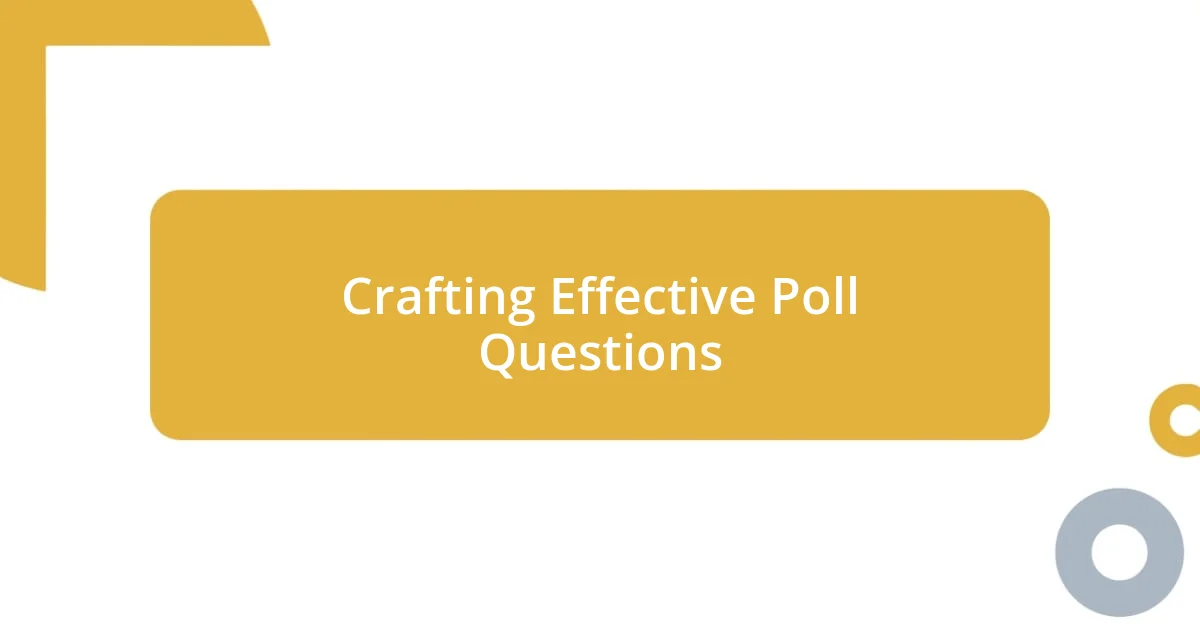
Crafting Effective Poll Questions
When it comes to crafting effective poll questions, clarity and relevance are key. I’ve learned that a well-phrased question can be the difference between an engaging poll and one that falls flat. I remember a time when I asked a wildly vague question, and the responses were so scattered that I ended up feeling lost instead of enlightened. Since then, I’ve focused on being specific and making sure every question serves a purpose in my broader engagement goals.
Here are some tips I follow for designing effective poll questions:
- Be Direct: Avoid jargon. Simple questions resonate more.
- Limit Choices: Too many options can overwhelm. Aim for 2-4 clear answers.
- Be Inclusive: Design questions that everyone can relate to or have an opinion on.
- Test the Waters: Start with a light question to ease into more complex topics.
- Encourage Reflection: Ask thought-provoking questions that spark deeper discussions.
Thinking about these elements has transformed how my audience interacts with my polls. I used to worry whether anyone would engage, but now, I feel a genuine thrill every time I see responses pouring in, as they reflect not just numbers, but real thoughts from real people.
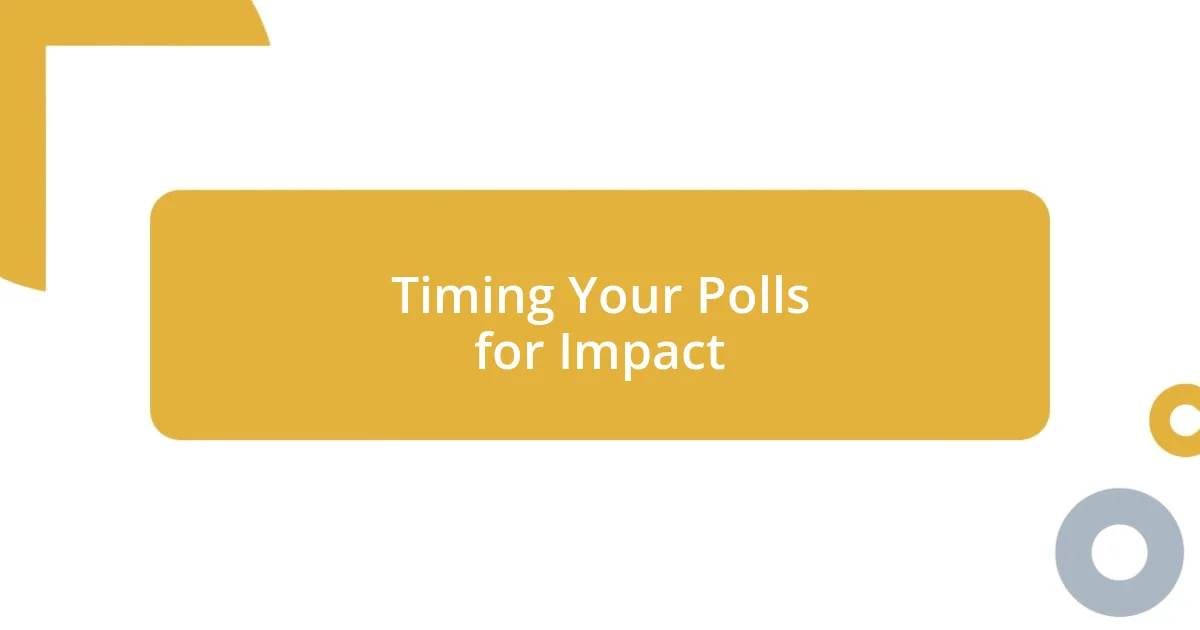
Timing Your Polls for Impact
Timing your polls can significantly impact engagement levels. From my experience, I’ve found that launching polls during peak activity hours maximizes exposure. There was a time when I released a poll early in the morning, only to realize later that most of my audience was still scrolling through their emails. The result? Minimal participation.
I’ve also learned the importance of synchronizing the poll with relevant events or trends. For instance, I once timed a poll about favorite summer activities right as summer vacation was beginning. The interaction skyrocketed! It seemed like everyone was eager to share their plans, and that excitement translated directly into engagement. Have you ever considered how current events might align with your audience’s interests? Finding that sweet spot can make a world of difference.
Lastly, I often revisit the frequency of my polls. Spacing them out appropriately keeps my audience curious and engaged without overwhelming them. I remember when I went through a phase of posting too frequently, thinking it would drive more interaction. Instead, I found my audience tuning out. Now, I aim for a balanced rhythm, giving my followers something to look forward to rather than just crunching through polls.

Promoting Your Polls
While reaching out to promote your polls, I’ve discovered that using social media strategically can create a buzz. Recently, I used Instagram Stories to share a sneak peek of an upcoming poll question, and it felt invigorating to see followers responding excitedly in real-time. Isn’t it fascinating how a little teaser can build anticipation and lead to remarkable participation?
Direct engagement with your audience also proves invaluable. On occasion, I’ve hosted quick live sessions to talk about the significance of the poll I was about to launch. The interactions were surprisingly vibrant, and I felt a strong connection with my audience as they shared their thoughts. Have you ever thought about how open discussions can spark interest in your polls? This interaction not only drives up participation but actually makes the questions feel more relevant to your audience.
Another approach that has worked wonders for me is collaborating with influencers or engaging community members who share similar interests. I remember partnering with a micro-influencer who passionately discussed my poll topic, and it opened the floodgates to a new demographic of participants. The sense of community strengthened the response, making the poll feel more like a shared experience rather than a mere inquiry. It’s intriguing how collaboration can amplify your reach while fostering a sense of belonging among your audience.
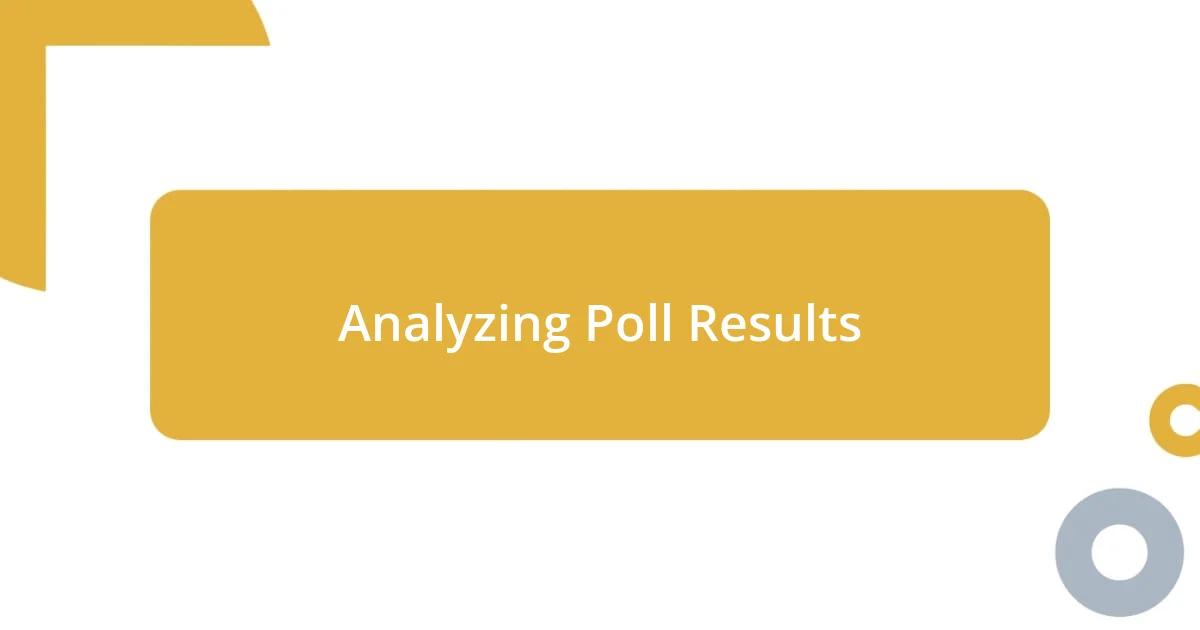
Analyzing Poll Results
Analyzing poll results is a pivotal step in understanding audience preferences. I recall a specific instance when I received feedback that took me by surprise; a poll asking about preferred content types revealed an undying love for video snippets, which I hadn’t expected. Want to know what followed? I quickly adapted my content strategy to cater to that insight, and the growth in audience engagement was palpable!
As I sift through the data, I often look for patterns and trends that might not be immediately obvious. Recently, after conducting a few polls on seasonal interests, I noticed a consistent spike in responses related to wellness during winter months. This led me to delve deeper and create focused content that resonated with my followers’ desires and needs at that time of the year. Isn’t it intriguing how even a small data set can illuminate broader sentiments?
Lastly, I make it a point to evaluate the quality of the responses, not just the quantity. There was a time when I focused solely on the number of votes but later realized that taking a closer look at comments or reactions gave me richer insights. For instance, feedback on a poll about holiday traditions revealed not just preferences but also touching personal stories that connected my audience on a deeper level. It makes me wonder – how often do we overlook the emotional stories behind the numbers in our pursuit of engagement?
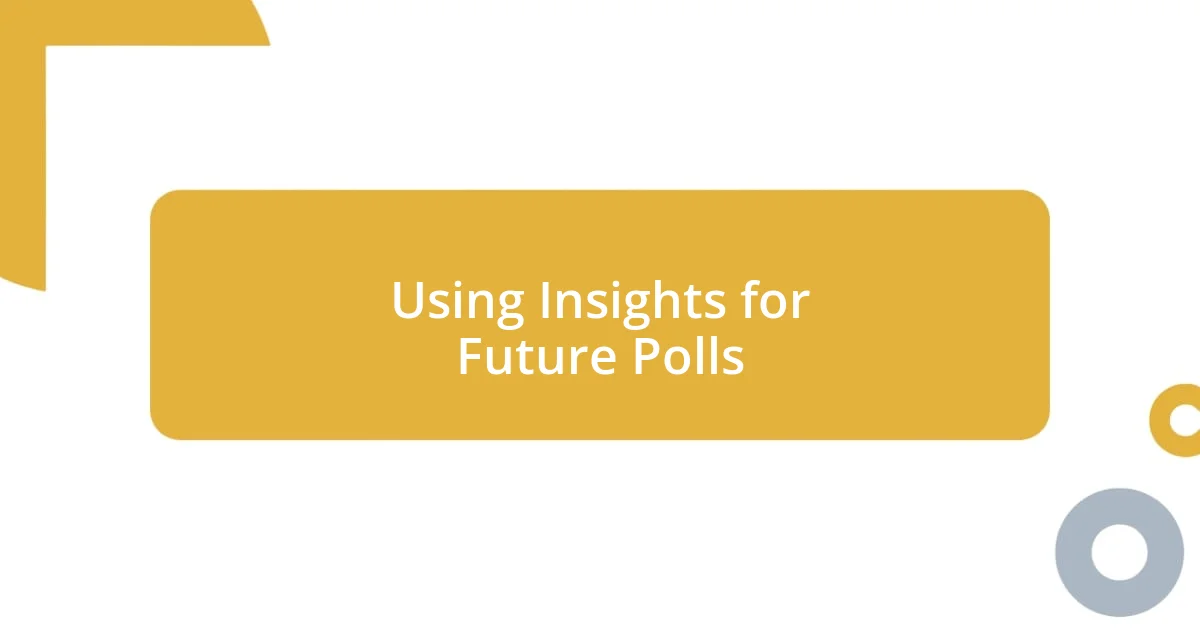
Using Insights for Future Polls
Once I’ve gathered insights from a poll, I always think about how they can shape future engagement strategies. For instance, after discovering a significant interest in sustainability through one of my recent polls, I began incorporating eco-friendly themes into my content. It was eye-opening to see how integrating these elements not only attracted more participants but also fostered a community that resonates with shared values. Have you noticed how aligning with your audience’s passions can create magnetic connections?
I also find it beneficial to revisit previous polls to analyze what worked and what didn’t. Reflecting on a past experience, I realized that a yes/no question I proposed about preferred communication methods didn’t elicit the depth I hoped for. Quite a few respondents expressed their thoughts in the comments instead of choosing an option, which led me to formulate open-ended questions for future polls. Isn’t it interesting how a little tweak in question format can reveal much richer narratives?
In forming new polls, I pay close attention to the timing as well. I once ran a poll during the holiday season and noticed a dramatic rise in engagement compared to other times of the year. It taught me the value of context—understanding when my audience is most likely to engage can dramatically influence response rates. How do you pick the right moment to connect with your audience? I find that leveraging insights from past engagement is key in anticipating their needs.












